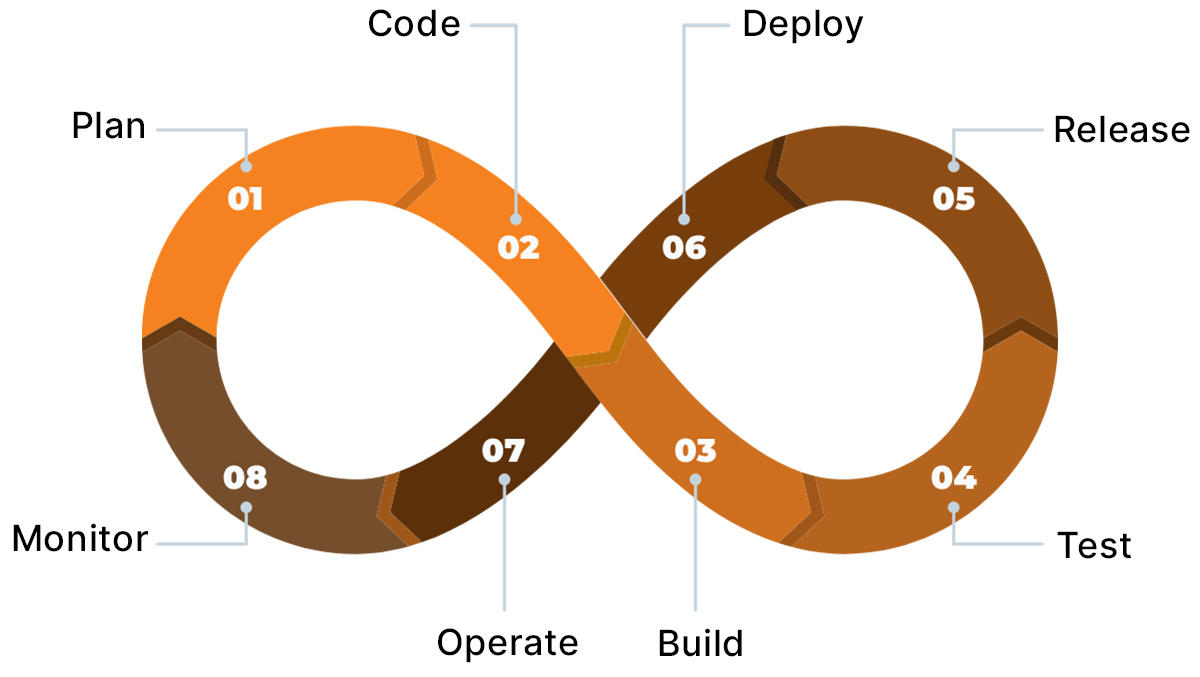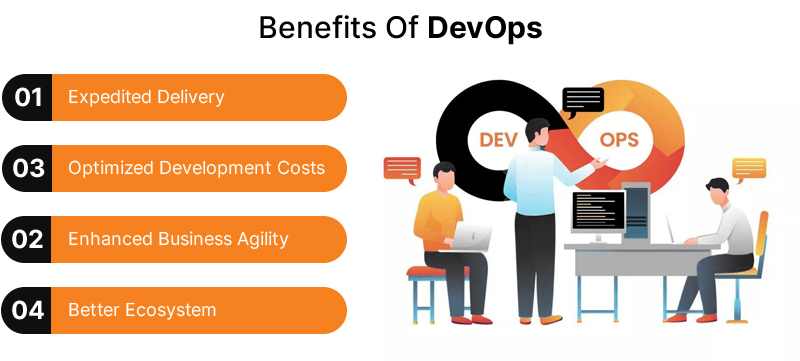A decade ago, the tech landscape witnessed a transformative shift as Facebook pioneered groundbreaking development practices, setting a new standard for efficiency and innovation. With the introduction of code ownership, automation, continuous improvement, and incremental changes, they were trailblazing a path that would eventually lead to the rise of DevOps in the development world.
Around 2015, a beloved global brand, Starbucks, embarked on its development journey. Departing from the traditional waterfall practices, they wholeheartedly embraced the agile Scrum framework. Emphasizing a dynamic “push” mentality, their development teams now diligently delivered code to testing teams before the final stage. This unexpected change inadvertently opened the doors for Starbucks to embrace DevOps principles fully.
Disney, in 2011, underwent a profound metamorphosis in their organizational structure. Having operated with functional teams dedicated to specific business lines, they made a remarkable leap toward a matrix team model. This innovative approach involved integrating a core DevOps team, a bridge connecting the technical staff and business units, fostering a harmonious and cohesive work environment.
These three industry giants, each with their unique trajectory, played a pivotal role in shaping the DevOps movement. Their early adoption of revolutionary practices laid the foundation for a more collaborative, efficient, and customer-centric approach to software development, which continues to shape today’s tech industry.
So if you are also interested in implementing DevOps, keep on reading.
What is DevOPs?

DevOps, the dynamic and adaptive approach, is a fusion of diverse cultural philosophies, cutting-edge tools, and effective practices, all orchestrated to infuse agility, efficiency, and remarkable velocity into the conventional software development landscape. Through the years, the tech giants spanning the globe have embarked on experimentation, exploring various methodologies and strategies to seamlessly integrate this paradigm into their unique ecosystems. At the same time, not every attempt bore fruit; a substantial number of them succeeded, becoming the bedrock upon which successful DevOps implementation was built. These triumphs have reshaped their internal development processes and become beacons of inspiration for the wider tech community, championing a new era of collaborative and innovative software delivery.
Benefits of Implementing DevOps in Your Enterprise
DevOps is an invaluable asset for enterprise development solutions, empowering businesses to thrive in the ever-evolving tech landscape by ensuring faster, cost-effective, and customer-centric software delivery.

1. Expedited Delivery
DevOps’s heart lies in empowering development teams to accelerate the software shipping process. Through the implementation of automated and streamlined tools in a robust CI/CD pipeline, manual tasks are minimized, and continuous delivery cycles thrive. This ensures rapid code-to-user experience transformation and brings valuable ancillary benefits such as enhanced release control, frequent software releases, and improved response times.
2. Optimized Development Costs
DevOps fosters a seamless collaboration between coders, testers, and DevOps engineers, who leverage automated software for testing and application deployment. The synergy between these teams leads to substantial budgetary savings. By eliminating time-consuming tasks, development costs are significantly reduced. Developers can focus on building more features, and implementation errors are minimized, decreasing technical debt.
3. Enhanced Business Agility
The integration of DevOps provides enterprises with a competitive edge, enabling swift adaptability to market shifts. The ability to deliver software faster and more cost-effectively allows companies to iterate on features rapidly, catering to the evolving demands of their target audience. This heightened agility translates into an elevated market position and increased application appeal.
4. Better Ecosystem
Embracing DevOps not only gratifies enterprises in terms of operational efficiency but also nurtures a positive work environment. The increased satisfaction and productivity of development teams contribute to creating exceptional software. At the same time, the swift delivery of products enhances customer satisfaction, ultimately attracting more customers to the company’s offerings.
Key Strategies for an Optimal DevOps Strategy
Incorporating a successful DevOps implementation strategy involves several essential elements that can significantly impact your business and streamline software development. Let’s delve into the prerequisites of a sound DevOps approach
1. Automated Regression Testing
One crucial aspect of DevOps is automated regression testing, ensuring that previous issues are thoroughly addressed in new app releases. Automating this testing process saves valuable resources, and the software’s operational stability is maintained upon release to the production environment. This practice enhances the overall quality and reliability of the software.
2. Daily Code Commits
Encouraging developers to commit their code changes to a shared code base daily is vital for a successful DevOps workflow. Consistent code commits promote continuous integration and help avoid last-minute conflicts and integration challenges that can hinder project progress. Daily code commits foster a collaborative and efficient development environment.
3. Shift Security Left in CI/CD Pipeline
Prioritizing security and compliance concerns early in the deployment lifecycle is essential. By “shifting security left,” organizations proactively address potential security issues during development, preventing costly crises and vulnerabilities later on. Integrating security testing in the CI/CD pipeline ensures a robust and protected software delivery process.
4. Loosely Coupled Architecture
Implementing a loosely coupled architecture enables flexibility and agility in software development. Modifying the codebase and adopting microservices architecture can make changes to specific components without affecting the entire system. This approach not only reduces regression testing efforts but also allows more time for innovation and the addition of new features.
5. Genuine Deployment Automation
While DevOps inherently involves automation, genuine deployment automation emphasizes using the same consistent mechanisms, tools, and procedures for deploying to both testing and production environments. Embracing infrastructure as code principles ensures a seamless and automated continuous deployment process, resulting in fewer errors and minimized downtime during software releases.
During the initial stages of DevOps implementation, businesses may experience a slight dip in productivity. However, the long-term gains in efficiency, speed, and overall software quality will far outweigh any temporary setbacks. By embracing these key DevOps strategy takeaways and utilizing product support services and AWS DevOps services, organizations can enhance their development practices, achieve faster and more reliable software releases, and remain competitive in today’s dynamic tech landscape.
Creating a Tailored DevOps Implementation Roadmap
A customized roadmap is essential to ensure a successful DevOps implementation that aligns with your business needs. Let’s outline the steps for your unique journey toward a streamlined and efficient DevOps environment.
1. Identify Bottlenecks
Begin by comprehensively assessing your current development processes to identify bottlenecks and pain points. Collaborate closely with all team members to gain insights into their challenges throughout the software development lifecycle.
2. Introduce Fitting Automation Tools
Based on the identified bottlenecks, carefully select and introduce appropriate automation tools that cater to your specific requirements. Leverage cutting-edge AWS DevOps remote solutions to empower your team and enhance their capabilities.
3. Secure Buy-In from All Team Members
A successful DevOps transformation relies on the collective commitment and enthusiasm of the entire team. Foster a culture of collaboration and cooperation by ensuring that all team members understand the value and benefits of DevOps. Involve them in decision-making and address their concerns to gain genuine buy-in.
4. Build the CI/CD Pipeline Gradually
Adopt a step-by-step approach in building your CI/CD pipeline to maintain stability and control. Begin with software compilation and gradually progress to automated testing, testing/prod environment roll-out, deployment to production, and application performance monitoring. Each step should be meticulously integrated and tested before moving on to the next.
5. Close the Loop with Monitoring
Establish a robust feedback loop by returning the results of application performance monitoring to the development team. This continuous feedback loop ensures prompt identification and resolution of any issues, fostering a culture of continuous improvement.
Anticipated Outcomes of DevOps Implementation
An effective DevOps implementation promises several positive outcomes that significantly enhance software development and delivery:
1. Increased Productivity
Developers and QA engineers will experience a notable reduction in time spent on repetitive tasks, leading to a boost in overall productivity. This increased efficiency enables more frequent and faster software releases.
2. Cost Reduction
Achieving automation in various stages of the development lifecycle significantly reduces the cost of deployment and software monitoring. Automation minimizes manual intervention, leading to cost savings over time.
3. Streamlined Software Delivery
DevOps streamlines the software delivery process, promoting seamless collaboration among teams. This synergy results in faster and more efficient delivery cycles, meeting the ever-changing demands of customers.
4. Enhanced Software Quality
The focus on automation, continuous integration, and testing fosters a culture of quality assurance, leading to improved software quality and fewer defects.
5. Agile Response to Changes
With DevOps in place, the development team becomes more adaptable and agile in responding to market changes and customer feedback, leading to greater customer satisfaction.
Factors to Keep in Mind During DevOps Implementation
Despite the numerous benefits of DevOps, there are some limitations and considerations to keep in mind:
1. Time and Training
Transitioning to a DevOps culture requires time and effort to train team members and ensure they understand their new roles and responsibilities. Some initial hiccups are expected during this transition phase.
2. Not a Fully Autonomous Solution
While automation is a key component of DevOps, human intervention is still necessary for certain tasks, such as optimizing configurations and updating software. DevOps still needs to eliminate the need for skilled professionals to manage and maintain the software.
Wrapping Up
The key to successful DevOps implementation lies in fostering a collaborative and adaptive work environment. Organizations embracing DevOps must recognize the importance of teamwork, communication, and continuous improvement.
To fully capitalize on the potential of DevOps, hiring a skilled DevOps Azure developer can be a game-changer. An experienced professional can help tailor your DevOps strategy to leverage Azure’s cloud capabilities, ensuring a seamless and efficient implementation. Collaborating with a competent DevOps expert can drive your business toward a successful and optimized software delivery process.
Summary
Kickstart Your Project With Us!
Popular Posts
CONTACT US
Let's Build Your Agile Team.
Experience Netsmartz for 40 hours - No Cost, No Obligation.
Connect With Us Today!
Please fill out the form or send us an email to







